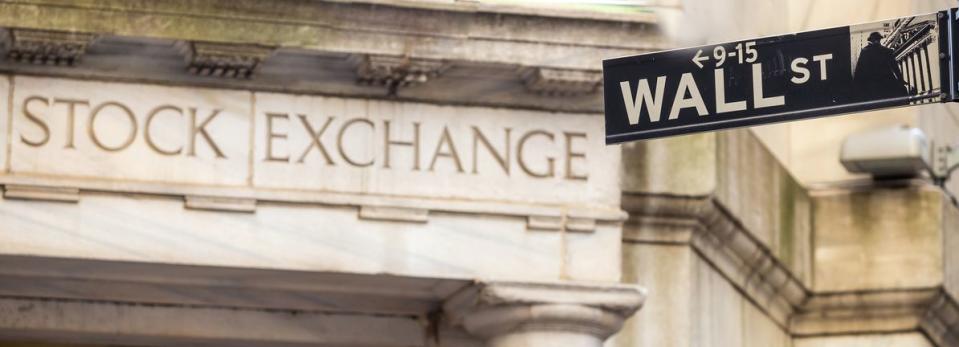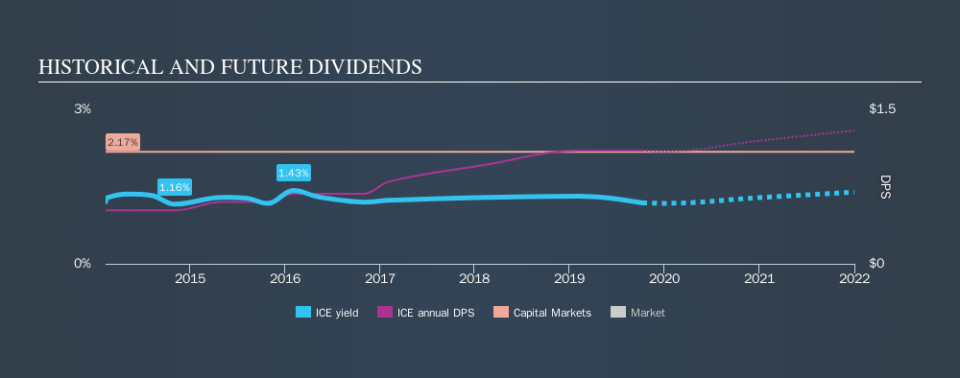What Makes Intercontinental Exchange, Inc. (NYSE:ICE) A Great Dividend Stock?

Dividend paying stocks like Intercontinental Exchange, Inc. (NYSE:ICE) tend to be popular with investors, and for good reason - some research suggests a significant amount of all stock market returns come from reinvested dividends. Yet sometimes, investors buy a stock for its dividend and lose money because the share price falls by more than they earned in dividend payments.
Investors might not know much about Intercontinental Exchange's dividend prospects, even though it has been paying dividends for the last six years and offers a 1.2% yield. A 1.2% yield is not inspiring, but the longer payment history has some appeal. The company also bought back stock equivalent to around 2.5% of market capitalisation this year. Some simple research can reduce the risk of buying Intercontinental Exchange for its dividend - read on to learn more.
Click the interactive chart for our full dividend analysis
Payout ratios
Dividends are usually paid out of company earnings. If a company is paying more than it earns, then the dividend might become unsustainable - hardly an ideal situation. Comparing dividend payments to a company's net profit after tax is a simple way of reality-checking whether a dividend is sustainable. In the last year, Intercontinental Exchange paid out 29% of its profit as dividends. A medium payout ratio strikes a good balance between paying dividends, and keeping enough back to invest in the business. Besides, if reinvestment opportunities dry up, the company has room to increase the dividend.
Remember, you can always get a snapshot of Intercontinental Exchange's latest financial position, by checking our visualisation of its financial health.
Dividend Volatility
From the perspective of an income investor who wants to earn dividends for many years, there is not much point buying a stock if its dividend is regularly cut or is not reliable. Intercontinental Exchange has been paying a dividend for the past six years. The company has been paying a stable dividend for a while now, which is great. However we'd prefer to see consistency for a few more years before giving it our full seal of approval. During the past six-year period, the first annual payment was US$0.52 in 2013, compared to US$1.10 last year. Dividends per share have grown at approximately 13% per year over this time.
The dividend has been growing pretty quickly, which could be enough to get us interested even though the dividend history is relatively short. Further research may be warranted.
Dividend Growth Potential
Dividend payments have been consistent over the past few years, but we should always check if earnings per share (EPS) are growing, as this will help maintain the purchasing power of the dividend. It's good to see Intercontinental Exchange has been growing its earnings per share at 36% a year over the past five years. With high earnings per share growth in recent times and a modest payout ratio, we think this is an attractive combination if earnings can be reinvested to generate further growth.
Conclusion
Dividend investors should always want to know if a) a company's dividends are affordable, b) if there is a track record of consistent payments, and c) if the dividend is capable of growing. We're glad to see Intercontinental Exchange has a low payout ratio, as this suggests earnings are being reinvested in the business. We were also glad to see it growing earnings, although its dividend history is not as long as we'd like. Intercontinental Exchange has a number of positive attributes, but falls short of our ideal dividend company. It may be worth a look at the right price, though.
Companies that are growing earnings tend to be the best dividend stocks over the long term. See what the 15 analysts we track are forecasting for Intercontinental Exchange for free with public analyst estimates for the company.
We have also put together a list of global stocks with a market capitalisation above $1bn and yielding more 3%.
We aim to bring you long-term focused research analysis driven by fundamental data. Note that our analysis may not factor in the latest price-sensitive company announcements or qualitative material.
If you spot an error that warrants correction, please contact the editor at editorial-team@simplywallst.com. This article by Simply Wall St is general in nature. It does not constitute a recommendation to buy or sell any stock, and does not take account of your objectives, or your financial situation. Simply Wall St has no position in the stocks mentioned. Thank you for reading.

 Yahoo Finance
Yahoo Finance 
